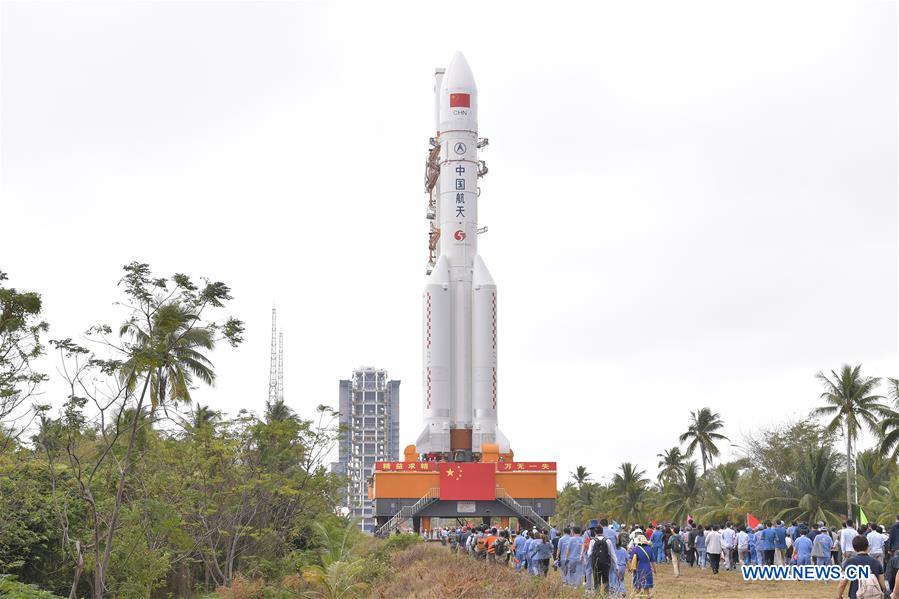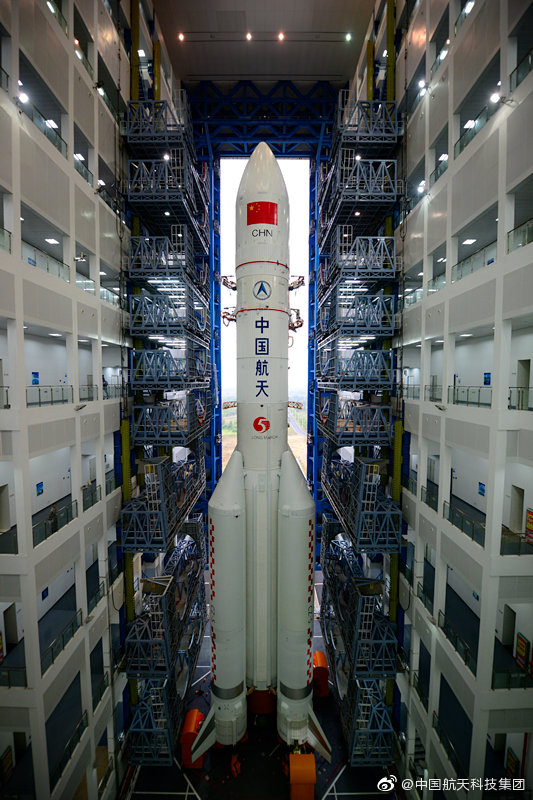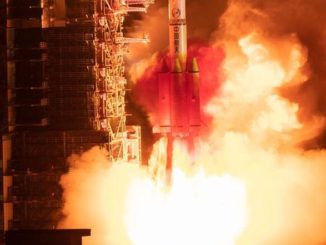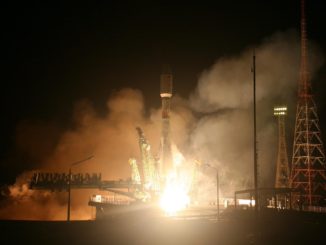
China’s Long March 5 rocket — the country’s most powerful launcher — is set for its third flight Friday on a critical validation mission after a core stage engine failure doomed a launch in 2017 and forced a two-and-a-half-year investigation and redesign effort.
A successful return-to-flight by the Long March 5 Friday would allow China to move forward with plans to launch a pair of ambitious robotic deep space missions using Long March 5 rockets in 2020.
China’s first Mars rover is scheduled for launch on a Long March 5 in mid-2020, and the Chinese Chang’e 5 lunar sample return mission will also require the Long March 5’s lift capability to depart Earth and head for the moon.
The launch of Chang’e 5 was delayed during the grounding of the Long March 5 after the 2017 failure. China’s Mars mission must launch during a several-week-long period in mid-2020, or else wait until 2022, when Earth and Mars are in the proper positions again to make a direct interplanetary journey possible.
A future variant of the Long March 5 rocket will also launch modules of China’s planned space station, scheduled to be completed in 2022, adding another layer of importance to Friday’s test launch.
The Long March 5 is the heaviest rocket in China’s fleet, and one of the most powerful launcher’s in the world. The Long March 5 can deliver up to 14 metric tons — nearly 31,000 pounds — to geostationary transfer orbit, a popular target orbit for large communications satellites.
Ground crews at the Wenchang Satellite Launch Center, located on Hainan Island in southern China, transferred the 187-foot-tall (57-meter) rocket to its launch pad Dec. 21 for final countdown preparations. The two-hour rollout from the Long March 5’s vertical assembly building — where teams stacked the rocket’s components — occurred on top of a mobile launch table.
Once at the launch complex on Hainan Island’s eastern coast, the Long March 5 was enclosed inside folding gantry structures inside a 300-foot-tall (92-meter) launch pad tower to give technicians access to the vehicle for final testing and inspections.
The launch from the Wenchang launch base — China’s newest spaceport — is planned Friday. Chinese officials have not disclosed the target launch time, but airspace warning notices released to pilots suggest the Long March 5 could lift off as soon as 1245 GMT (7:45 a.m. EST; 8:45 p.m. Beijing time) Friday.
Chinese state television stations have broadcast previous Long March 5 launches, but authorities have not indicated any plans for an official live video feed of Friday’s mission.
When it takes off, ten liquid-fueled engines will power the Long March 5 rocket off the launch pad with nearly 2.4 million pounds of thrust.
The Long March 5’s flight path will take the rocket east from Hainan Island over the South China Sea, where it will drop its four-strap on boosters — each powered by two kerosene-fueled YF-100 engines — around three minutes after liftoff. Unlike launches from China’s inland spaceports, missions originating from Wenchang follow trajectories over the sea, allowing rockets to jettison stages over water rather than over land.

Two YF-77 engines on the Long March 5’s core stage will burn super-cold liquid hydrogen and liquid oxygen propellants for nearly eight minutes. During the first stage burn, the Long March 5 will jettison its clamshell-like payload fairing once the launcher climbs above the thick, lower layers of the atmosphere.
Two restartable hydrogen-fueled YF-75D engines drive the Long March 5’s second stage. The second stage engines are expected to perform two firings before deploying the Shijian 20 communications satellite into an elliptical, or egg-shaped, transfer orbit stretching more than 22,000 miles (nearly 36,000 kilometers) from Earth at its most distant point.
The Shijian 20 spacecraft will use its own propulsion system to circularize its orbit at geostationary altitude more than 22,000 miles over the equator.
China’s third Long March 5 launch is expected to follow the same profile that engineers planned for the second Long March 5 flight in July 2017.
But a first stage engine failure on that mission prevented the rocket from reaching orbit, destroying the Shijian 18 communications satellite. China declared the first Long March 5 launch in November 2016 a success, despite a rocket problem that forced the Long March 5’s Yuanzheng upper stage to burn longer to place the Shijian 17 technology demonstration satellite into its planned orbit.
Investigators traced the cause of the July 2017 launch failure to a turbopump on one of the Long March 5’s two YF-77 first stage engines.
The YF-77 engine failure occurred in a “complex thermal environment” around six minutes after liftoff, leading to an instantaneous loss of thrust, according to Chinese investigators. Engineers redesigned the engine turbine exhaust structure for future Long March 5 missions, forcing officials to scrap engine parts already in stock.
The changes led to a gap of more than two years between the second and third Long March 5 flights. In the interim between launches, engineers conducted test-firings of the modified YF-77 engine to verify the design changes, according to the State Administration for Science, Technology and Industry for National Defense, or SASTIND, the Chinese government agency that oversees the country’s space activities.
The YF-77 engines were developed specifically for the Long March 5, the largest rocket in China’s fleet.
The Shijian 20 satellite poised for launch Friday will replace the Shijian 18 satellite lost on the Long March 5 failure in 2017.
Based on the new DFH-5 satellite design developed by the China Academy of Space Technology — a state-owned satellite manufacture — the Shijian 20 spacecraft will test new technologies to support higher-throughput data links with users on the ground.
Shijian 18 was also intended to test new higher-power ion thrusters. Shijian 20 may carry similar propulsion technology.
Email the author.
Follow Stephen Clark on Twitter: @StephenClark1.



